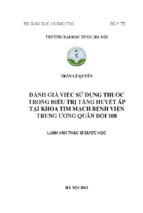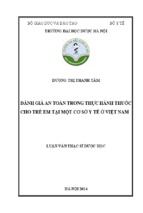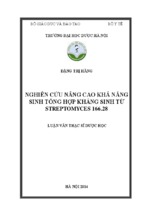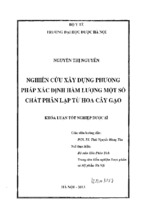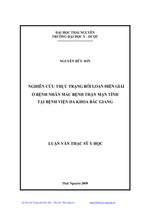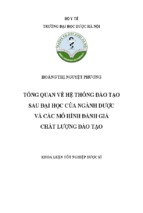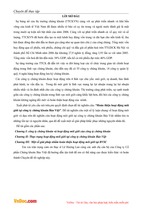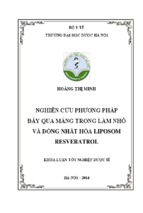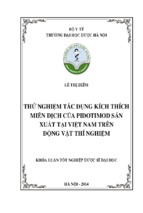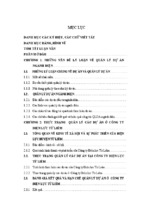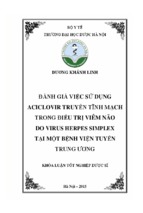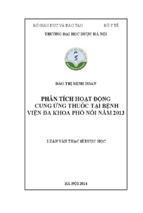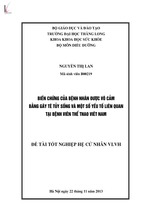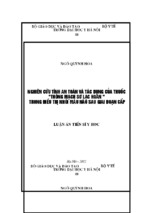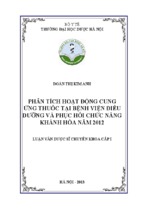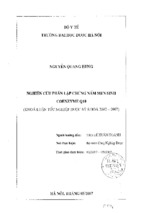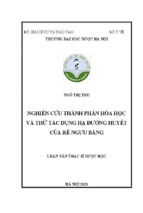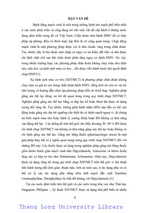DECLARATION OF ORGINALITY
AND WORD COUNT
I hereby declare that the graduation project is based on my original work except for
quotations and citations which have been duly acknowledged. I also declare that it
has not been previously or concurrently submitted for any other course/degree at
HELP University College or other institutions.
The word count is 10.217 words.
NGUYEN HONG NHUNG
October 2011
-1-
ACKNOWLEDGEMENT
This study would not have been made without the assistance, support and
encouragement of many people. I wish to take this opportunity to thank all people
who helped me during the time I carried out this project.
First of all, I would like to express my gratitude to my supervisor, Dr.Pham Duc
Hieu, in Viet Nam Commercial University. He has kindly guided, supported, and
encouraged me from the very beginning of this study.
Furthermore, I would like to give my thankfulness to Ms. Sumathi and Ms. Shenba at
Help University College, who initiated the project and give me instruction and
support.
Additionally, I would like to thank the interview participants: Mr. Dao Hung Dung,
Deputy Manager of planning & investment Department of VIPACO and Mr. Phan
Thanh Ngoc - Deputy Manager of planning & investment Department of
Vinaconex-ITC, who helps me conduct the interview. I also would like to extend my
special thanks to manager, customers, students, employers of both VIPACO and
Vinaconex-ITC, and my friends to help me carry out the survey.
Finally, I would like to thank all family members to support and encourage to
complete my project.
-2-
INFLUENCE OF CORPORATE SOCIAL RESPONSIBILITIES
(CSR) ON SMALL AND MEDIUM ENTERPRISES (SMEs) IN
VIETNAM
BY
NGUYEN HONG NHUNG
E0700276
OCTOBER 2011
Supervisor: Dr. Pham Duc Hieu
ABSTRACT
For many years ago, the concept and component of Corporate Social
Responsibility (CSR) was recognized and implemented commodiously by
international business environment, however this concept is quite new to Small and
Medium Enterprises (SMEs) in Vietnam.
Because Vietnam is the developing country and new member of WTO, thus CSR
issue becomes the necessary and sufficient. Therefore, the main purpose of this study
wants to discuss about the assessment of understanding of the concept, components,
and implementation of CSR with (SMEs) in Vietnam. Moreover, this study wants to
find out the impact of CSR within the development process of company. The result
of this study is the clearly evidences by collecting data from the advisory of
company, researching process and questionnaires.
-3-
TABLE OF CONTENT
DECLARATION OF ORGINALITY AND WORD COUNT ................................ 1
ACKNOWLEDGEMENT ......................................................................................... 2
ABSTRACT ................................................................................................................ 3
TABLE OF CONTENT ............................................................................................. 4
LIST OF FIGURES ................................................................................................... 7
LIST OF CHARTS .................................................................................................... 8
LIST OF ABBREVIATIONS ................................................................................... 9
CHAPTER 1: INTRODUCTION ............................................................................ 10
1.1 CSR in Vietnam .................................................................................................... 10
1.2 CSR in SMEs company ........................................................................................ 11
1.3 Government actions .............................................................................................. 12
1.4 CSR practice and challenge ................................................................................. 14
1.5 Research questions ................................................................................................ 15
CHAPTER 2: LITERATURE REVIEW ................................................................ 16
2.1 Definition and components of CSR ...................................................................... 16
2.2 Theories related to CSR ....................................................................................... 17
2.2.1 Carroll’s “Pyramid of CSR” ........................................................................... 17
2.2.2 Wood 1991 conceptualization ......................................................................... 21
2.2.3 Stakeholder theory .......................................................................................... 23
2.2.4 Triple bottom line theory ................................................................................ 24
2.3 Responsibility of the SMEs .................................................................................. 27
CHAPTER 3: RESEARCH METHODOLOGY ................................................... 29
-4-
3.1 Research Objectives ............................................................................................ 29
3.2 Research methodology ........................................................................................ 29
3.3 Data source .......................................................................................................... 30
3.3.1 Primary data ............................................................................................... 30
3.3.2 Secondary data ........................................................................................... 30
3.4 Research strategy ................................................................................................ 31
3.5 Research instruments .......................................................................................... 31
3.5.1 Questionnaire ............................................................................................ 31
3.5.2 Personal interview .................................................................................... 31
3.6 Data collection .................................................................................................... 32
3.7 Sampling ............................................................................................................. 32
3.8 Limitation of research .......................................................................................... 32
CHAPTER 4: DESCRIPTION AND ANALYSIS OF RESULT ........................ 33
4.1 Introduction about Vinaconex - ITC & VIPACO - JSC ..................................... 34
4.1.1 Introduction about Vinaconex Investment and Tourism Development Joint –
stock Company (Vinaconex – ITC) .......................................................................... 34
4.1.2 Introduction about VIPACO Joint Stock Company ( VIPACO - JSC) ...... 35
4.2 Description of Respondents’ information ........................................................... 36
4.2.1 Description of respondents’ age .................................................................. 36
4.2.2 Description of respondents’ gender ............................................................ 37
4.2.3 Description of respondent’s education level ............................................... 37
4.3 Description and Analysis the understanding CSR concept of respondents ........ 38
4.4 Evaluation of CSR implementation .................................................................... 39
4.4.1 Description and Analysis of Questionnaire about Vinaconex – ITC .......... 39
4.4.2 Description and Analysis of Questionnaire about VIPACO ....................... 41
-5-
4.4.3 Description and Analysis of Questionnaire for managers of Vinaconex –
ITC and VIPACO ............................................................................................. 43
4.5 Evaluation of Sustainability development and CSR implementation ................ 44
4.5.1 Description and Analysis of Questionnaire about Vinaconex – ITC and
VIPACO ........................................................................................................... 44
4.5.2 Description and Analysis of Questionnaire for managers of Vinaconex –
ITC and VIPACO ............................................................................................. 47
4.6 Overall Discussion .............................................................................................. 50
CHAPTER 5: CONCLUSION AND RECOMMENDATION .......................... 52
5.1 Conclusion .......................................................................................................... 52
5.2 Recommendation.................................................................................................. 53
5.3 Limitation of study .............................................................................................. 54
5.4 Suggestion for future research ............................................................................ 55
REFERENCE ............................................................................................................ 56
APPENDIX ............................................................................................................... 59
-6-
LIST OF TABLES & FIGURES
Figures 2.1 Carroll’s “Pyramid of CSR”
Figures 2.2 Economic & Legal Component of CSR
Figures 2.3 Ethical and Philanthropic Component of CSR
Figures 2.4 Triple bottom line theory
Figure 2.5 Planet – People- Profit in TBL theory
Table I Corporate Social Performance model
Table 4.1 General information about VINACONEXT - ITC
Table 4.2 General information about VIPACO
-7-
LIST OF CHARTS
Chart 4.1 Age frequency of respondents
Chart 4.2 Gender frequency of respondents
Chart 4.3 Education level frequency of respondents
Chart 4.4 Description of Result – Question 1
Chart 4.5 Description of Result – Question 2 – Questionnaire for V – ITC
Chart 4.6 Description of Result – Question 3 – Questionnaire for consumers of
Vinaconex – ITC
Chart 4.7 Description of Result – Question 2 – Questionnaire for consumers of
VIPACO
Chart 4.8 Description of Result – Question 3 – Questionnaire for consumers of
VIPACO
Chart 4.9 Description of Result – Question 4 – Questionnaire for consumers of
Vinaconex – ITC and VIPACO
Chart 4.10 Description of Result – Question 5 – Questionnaire for consumers of
Vinaconex – ITC and VIPACO
Chart 4.11 Description of Result – Question 6 – Questionnaire for consumers of
Vinaconex – ITC and VIPACO
Chart 4.12 Description of Result – Question 4 – Questionnaire for managers of
Vinaconex -ITC and VIPACO
Chart 4.13 Description of Result – Question 5 - Questionnaire for managers of
Vinaconex – ITC and VIPACO
-8-
LIST OF ABBREVIATIONS
SMEs
SMALL AND MEDIUM ENTERPRISES
CSR
COPORATE SOCIAL RESPONSIBILITY
TBL
TRIPLE BOTTOM LINE
WTO
WORLD TRADE ORGANIZATION
PR
PUBLIC RELATION
NGOs
NON-GOVERNMENTAL ORGANIZATIONS
CSP
COPORATE SOCIAL PERFORMANCE
EIA
ENVIRONMENT IMPACT ASSESSMENT
-9-
CHAPTER 1: INTRODUCTION
1.1 CSR in Vietnam
Corporate Social Responsibility (CSR) is more concentration in the world.
However, the importance role of CSR has not really high evaluated in Vietnam. Due
to the today’s global CSR, companies should focus on not only good and high quality
products but also human rights, labor conditions and environment. According to the
director of Vietnam Chamber of Commerce and Industry, PhD Doan Duy Khuong,
“CSR has become necessary requirement for each company, if the company does not
embrace CRS, they cannot approach the global market” (http://www.saga.vn)
Nowadays, CSR is still new concept because of lack awareness of public and
business community. This issue is the main factor influences much on the CSR
practices. Due to the economic integration process, the awareness of the CSR issue
has been changed but has not the most effective consequence.
Recently, Vietnamese enterprises become more and more actively in their social
responsibility in various areas include consumer’s satisfaction and employer’s health
care, student’s scholarships and environmental protection activities. They realized
the vital of CSR performance and carry out CSR application in their business, since
they will receives more advantages than competitors. When the companies care
about employees such as their life and working conditional, it leads to raise
employees’ loyalty and more productivity. Moreover, together with good
implementation of protection environment and society, they will make their brand
name more popular and more reliable. One more important is attracting more
investors and more shareholders’ belief. That is reason why many companies
identified the relationship between CSR and sustainability and step-by-step complete
-10-
this interactive relationship. In short, we believe that will have the positive changes
CSR performance in near future.
1.2 CSR in SMEs Company
The fact that most of companies in Vietnam are small and medium enterprises
that withholds about 95%. SMEs devices into two groups include small enterprises
have engage up to 49 employees and medium size enterprises engage up to 299
employees.This research will discuss how they carry out CSR.
Most the kind of company lack CSR knowledge, therefore they always focus on
annual financial statements reports and miss non-financial performance. Moreover,
they just understand simply that the CSR means the charity task not starting from
their own business. Besides, CSR cannot implement because of not enough financial
resources and techniques to adapt to CSR’s standards.
Base on the growing of economic, all the principle purpose of SMEs wants to
make profit and gain revenue that is reason why the CSR’s application and
implementation is not attention and concentrate.
For example: The event of melamine- tainted milk from China and the Vedan Vietnam corporation discharge wastewater directly into Thi Vai river without
treatment.
However, Some SMEs apply successfully CSR into the business strategy such as
Vinamilk with “Six million glass of milk for children fund” and “Den Dom Dom”
scholarship fund of Dutch Lady. These actions were supported vigorously from
society.
Secondly, SMEs should consider and valuate the employees’ awareness and
commitment with CRS especially the Management, Accountant, Consumers:
-11-
Hill and Jones (1992) define the relationship between stakeholders and managers
likes “Managers are the only group of stakeholders who enter into a contractual
relationship with all other stakeholders. Managers are also the only group of
stakeholders with direct control over the decision making process of the firm”.
Therefore, it is necessary agreement and commitment of managers to carry out and
improve CSR issue. In Vietnam, two questions of management take into account
CSR issue: What do managers consider the responsibility as an important part of
doing business? And why do managers address CSR?
Nowadays, CSR has recently tends to the marketing area. Customers want to
understand firm’s social, ethical, and environmental project how influences
marketplace outcomes. For example, the tendency of using the “green” product is
more and more general.
Accountants have significant in contribution CSR report. Due to the traditional,
accountants prepared the requirement financial statement. However, many years
recently, the accounting academics have been considered study and theory on social
and environmental accounting practitioners, professional reporting reliable CSR
information.
1.3 Government actions
CSR plays an important influence in developing of economic that is reason why
the government always provides not only new Acts and Regulations but also editting
and supplementing ones to achieve the requirement of public. One of the edition and
supplement is the replacement of Environmental Protection Law 1994 in 2005, and
the polluting cases investigation done by the Environmental Police Department
(C36).
-12-
In 1986, A policy of greater openness named “Doi Moi” was promulgated with
purpose transforming Vietnam from a planned economy into “socialist market
economy”. The Doi Moi and open door policies bring advantage in increase
economic grow in 2006, GDP grew by 8.2% compared with last period. However,
main social issues still existence especial the difference between rich and poor
people, environmental degradation include air, noisy, water pollution and the rapidly
raising the industrial accident. Furthermore, the conflict between the employee and
bosses problem should be taken into account.
The government continued to introducing new rule and regulations to control above
issue and has strengthened the legal of implement mechanism however, the
implement is sporadic, vary of legal interpretations and appearance corruption
activities.
In Vietnam, the legal framework of CSR practices focuses on environment and
labor issues and company- related laws. It can see that international conventions
becomes the essential factor which leads to CSR- relevent legislation.
There are some Government regulations and Laws related to CSR practical. For
example, the most important labor laws are Labor Code (1994, edited in 2002), Law
on Trade Unions (1990), Law on Environmental Protection (1991, amended in
2005), Law on Social Insurance (2006). Besides, the Government Regulations –
Laws relevant to environmental issues include Law on Special Consumption Tax
(2004), Law on Environmental Protection (2006), Law on Water Resources (1998),
and Electricity Law (2005). Moreover, The Grassroots Democratic Ordinance in
2007 applies the participation of stakeholders at local level with respect to social
economic development, environmental protection and infrastructure planning.
-13-
1.4 CSR practice and challenge
According to PhD Doan Du Khuong_VCCI Vice Director, President business
council for Sustainable Development of Vietnam (VBCSD) "Business associated
with social responsibility not only help improve the competitiveness of enterprises on
the path of integration but also the driving force contributing to growth and
prosperity in every country".(http://vccinews.vn)
Together with the important of CSR performance, Vietnam attains some of CSR
Awards that created Vietnam chamber of Commerce and Industry, Ministry of
Labor- Invalids and Social Affairs, Vietnam Ministry of Industry and Trade since
2005.
Because of the above discussion, the implementation of CSR in SMEs have much
difficulties. First of all, the awareness of managers about the social responsibility in
the competition market, they just think voluntary contribution from one part of their
profit while CSR should be in production process. Besides, Vietnamese SMEs have
not accessed and applied the standard of global CSR that have effective implement in
developing country. And one of important challenge which SMEs have to face is the
finacial problem and the technical to carry out CRS standard. For example, the
socialist system always expects companies dropping property, create more jobs,
overcome obstacles and difficulties of raising disadvantaged regions and groups.
However, the most of companies can not do that.
Following Mr. Khuong’s suggestion, the implement of CSR has the effective result,
it should have the organization’s supervises plays advisory role for companies and
the Government and makes policies assistance for CSR appliance.
-14-
1.5 Research questions
Due to evaluate the impact of CSR in SMEs in Vietnam, there are many
questions are developed and try to explain as:
What is the fact of CSR in SMEs in Vietnam?
How long does the issue relating CSR the term into Vietnamese society
especially SMEs?
How does the small and medium enterprises operating in Vietnam relate to
this area?
-15-
CHAPTER 2: LITERATURE
REVIEW
2.1 Definition and conceptualization of CSR
Firstly, there are various of definitions, conceptualization and relevant components
of corporate social responsibilities. In general, The European Commission's
definition of CSR is "A concept whereby companies integrate social and
environmental concerns in their business operations and in their interaction with
their stakeholders on a voluntary basis." 1 Another definition include Carroll (19791991) and by Wood (1991).
The role of CSR was described as “Corporate Social Responsibilities has become
important because globalization and the growth in competition, increased size and
influence of companies, retrenchment or repositioning of government and its roles,
war for talent, companies competing for expertise, growth of global civil society
activism, increased importance of intangible assets” 2 (UNIDO, 2002, p.1)
Besides, there are many of CSR instrument and tools for building the information
structure to communicate CSR. “Corporate Social Responsibilities Reports feature
and link to recently published, non-financial Corporate Social Responsibility and
Sustainability reports. The CSR Reports page also lists any press releases associated
with the publication of a given report.”3 The Triple Bottom Line (TBL) reporting
1
http://ec.europa.eu/enterprise/policies/sustainable-business/corporate-socialresponsibility/index_en.htm
2
http://www.csr-weltweit.de/uploads/tx_jpdownloads/FDI_CSR_Vietnam.pdf
3
http://www.csrwire.com/reports
-16-
was defined by Elkington (1997) presented information about economic,
environmental and social within three P’s: People, Planet and Profit.
In summary, almost the definition and conceptualization mention about the company
should embrace responsibility with environment, customers, employers, citizens,
stakeholders, and the other entire society member. Moreover, CSR implementation
wants to concentrate on promoting the public interest such as encouraging
community development and voluntarily eliminating activities that harm the social
sphere irrespective of legality and ethical.
2.2 Theories related to CSR
In order to understand more clearly and exactly about CSR, there are many
concepts and conceptualization related to CSR will be mentioned below.
2.2.1 Carroll’s “Pyramid of CSR”
Figure 2.1:
-17-
Figure 2.2:
Figure 2.3:
-18-
Among developing conceptualization and different definition, the concept of
Carroll, Archie B. named “Pyramid of CSR” which known as the popular and used
widely in the world. The Carroll’s Four part definition include Economic
Responsibilities (Make a profit), Legal Responsibilities (Obey the law), Ethical
Responsibilities (Be ethical) and Philanthropic Responsibilities (Good corporate
citizen).
Basing on figure 2.1, the first category mentioned about economic responsibilities
which indicated that making profit is the principal role and evaluated as the top of the
business organisation. It can be said that the effective growing of the company is
illustrated by the company’s profitable. However, the econmic aspect in Carroll’s
concept mentions not only earning profit but also the responsibilities with their
customer, shareholder. For example, each company has responsibilities to provide
the goods and services with high qualities, suitable price and satisfied with
customer’s demand. When company can do that, they will recieves customer’s loyal
and commits the effecetive development and make the maximum of investment from
stakeholder. Therefore, each company complete responsibilities in economic, it
means have reliable foundation to move the next aspects.
The sencond aspection which carry out the responsibilities of company is legal
ones which obey the Law, Provisions, Regulars, Articles and the other legal
document related which issued by Goverment and local authotities. This
legal
responsibilities
enhance the society’s expectation which the business fullfil with the regulation, laws
to achieves economic mission and legal frameworks set up by societal legal system.
For instance, all the manufacturing industrial that thrown the waste of productions
without disposal directly into the environment such as smoke into the sky,waste
-19-
water and so on which can not be knonw as well-perform of legal responsibilities.
Therefore, company should improve the customer’s right protection, environment
protection, fair in competion in business environment to have better performance and
stand on violent competition market.
The third aspection was mentioned ethical responsibilities. The fact that, because
the ethical responsibilities had great influence much on the company. It is the key
factor help the company to overcome with the limitation of law. Nowadays, the
companies make threats against citizen because of some of company accepts to do
anything to gain more profit. For example: fraudulent, bribes, discrimination in
working places. Therefore, besides the legal responsibilities, company has to take
into account the ethical include the human principals and human rights commitment.
However, the defintion of ethical is difficult because ethics is intangible, then the
company should take care the expect of social about the ethical norms and consider
carefully to avoid breaking ethical standard.
In short, the hightest aspection of social responsibilities is Philanthropic
responsibilities or good corporate citizen. In this areas, the company can improve the
people’s life include citizen and employer, moreover, it makes company’s reputation
more and more popular. Each company has own strategy to perform thier
responsibilities however they have the same puposes that contribute and buid in
humanitaian program. For instance, company contribute thier fund to do charity for
poor people and illness people such as Vinamik, Viettel, Mobifone...
Another activies as the managers and staff of company has volunteer activities in
local community to increase the relationship between company and citizen. One of
the bad image
is Vedan company, they made waste polution and evaded
resonsibilities with people who live and depend much on Thi Vai river.
-20-
- Xem thêm -

